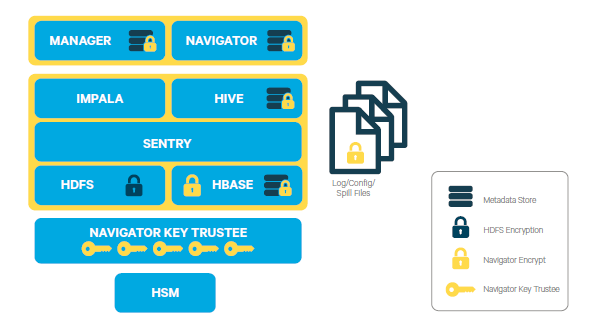Protecting Data At-Rest
Protecting data at rest typically means encrypting the data when it is stored on disk and letting authorized users and processes—and only authorized users and processes—to decrypt the data when needed for the application or task at hand. With data-at-rest encryption, encryption keys must be distributed and managed, keys should be rotated or changed on a regular basis (to reduce the risk of having keys compromised), and many other factors complicate the process.
However, encrypting data alone may not be sufficient. For example, administrators and others with sufficient privileges may have access to personally identifiable information (PII) in log files, audit data, or SQL queries. Depending on the specific use case—in hospital or financial environment, the PII may need to be redacted from all such files, to ensure that users with privileges on the logs and queries that might contain sensitive data are nonetheless unable to view that data when they should not.
Cloudera provides complementary approaches to encrypting data at rest, and provides mechanisms to mask PII in log files, audit data, and SQL queries.
Encryption Options Available
Cloudera provides several mechanisms to ensure that sensitive data is secure. CDH provides transparent HDFS encryption, ensuring that all sensitive data is encrypted before being stored on disk. HDFS encryption when combined with the enterprise-grade encryption key management of Navigator Key Trustee enables regulatory compliance for most enterprises. For Cloudera Enterprise, HDFS encryption can be augmented by Navigator Encrypt to secure metadata, in addition to data. Cloudera clusters that use these solutions run as usual and have very low performance impact, given that data nodes are encrypted in parallel. As the cluster grows, encryption grows with it.
Additionally, this transparent encryption is optimized for the Intel chipset for high performance. Intel chipsets include AES-NI co-processors, which provide special capabilities that make encryption workloads run extremely fast. Cloudera leverages the latest Intel advances for even faster performance.
The Key Trustee KMS, used in conjunction with Key Trustee Server and Key HSM, provides HSM-based protection of stored key material. The Key Trustee KMS generates encryption zone key material locally on the KMS and then encrypts this key material using an HSM-generated key. The Key Trustee KMS remains the recommended key management solution for HDFS encryption for most production scenarios.
- Cloudera Transparent HDFS Encryption to encrypt data stored on HDFS
- Navigator Encrypt for all other data (including metadata, logs, and spill data) associated with Cloudera Manager, Cloudera Navigator, Hive, and HBase
- Navigator Key Trustee for robust, fault-tolerant key management

In addition to applying encryption to the data layer of a Cloudera cluster, encryption can also be applied at the network layer, to encrypt communications among nodes of the cluster. See Encryption Mechanisms for more information.
Encryption does not prevent administrators with full access to the cluster from viewing sensitive data. To obfuscate sensitive data, including PII, the cluster can be configured for data redaction.
Data Redaction for Cloudera Clusters
Redaction is a process that obscures data. It can help organizations
comply with industry regulations and standards, such as PCI (Payment Card Industry) and HIPAA, by obfuscating personally identifiable information
(PII) so that is not usable except by those whose jobs require such
access. For example, HIPAA legislation requires that patient PII not
be available to anyone other than appropriate physician (and the
patient), and that any patient's PII cannot be used to determine or
associate an individual's identity with health data. Data redaction is
one process that can help ensure this privacy, by transforming PII to
meaningless patterns—for example, transforming U.S. social security
numbers to XXX-XX-XXXX strings.
Data redaction works separately from Cloudera encryption techniques, which do not preclude administrators with full access to the cluster from viewing sensitive user data. It ensures that cluster administrators, data analysts, and others cannot see PII or other sensitive data that is not within their job domain and at the same time, it does not prevent users with appropriate permissions from accessing data to which they have privileges.
See How to Enable Sensitive Data Redaction for details.

